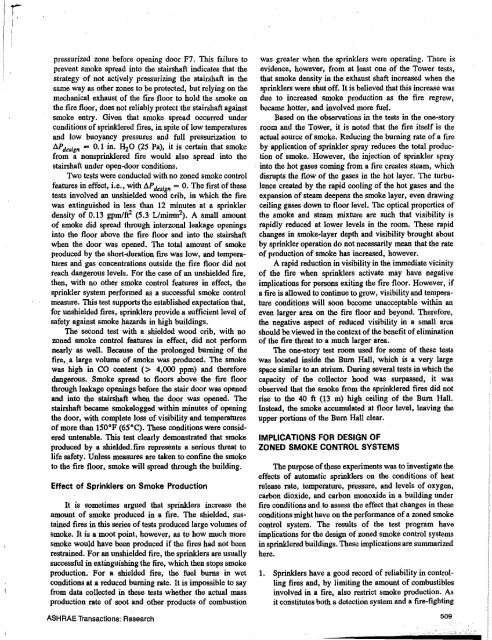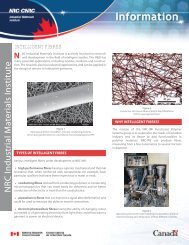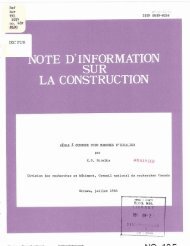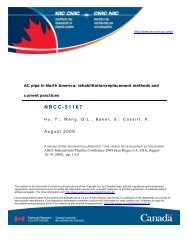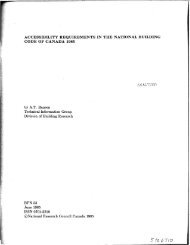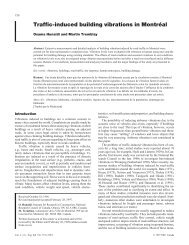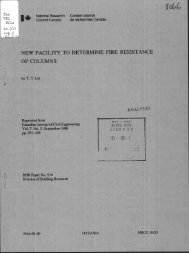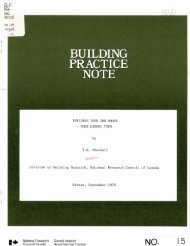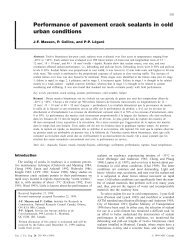Effect of Automatic Sprinkler Protection on Smoke Control Systems
Effect of Automatic Sprinkler Protection on Smoke Control Systems
Effect of Automatic Sprinkler Protection on Smoke Control Systems
You also want an ePaper? Increase the reach of your titles
YUMPU automatically turns print PDFs into web optimized ePapers that Google loves.
Ipressurized z<strong>on</strong>e before opening door F7. This failure toprevent smoke spread into the stairshaft indicates that thestrategy <str<strong>on</strong>g>of</str<strong>on</strong>g> not actively pressurizing the stairshaft in thesame way as other z<strong>on</strong>es to be protected, but relying <strong>on</strong> themechanical exhaust <str<strong>on</strong>g>of</str<strong>on</strong>g> the fire floor to hold the smoke <strong>on</strong>the fire floor, does not reliably protect the stairshaft againstsmoke entry. Given that smoke spread occurred underc<strong>on</strong>diti<strong>on</strong>s <str<strong>on</strong>g>of</str<strong>on</strong>g> sprinklered fires, in spite <str<strong>on</strong>g>of</str<strong>on</strong>g> low tempemturesand low buoyancy pressures and full pressurizati<strong>on</strong> toAPdesign = 0.1 in. H20 (25 Pa), it is certain that smokefrom a n<strong>on</strong>sprinklered fire would also spread into thestairshaft under open-door c<strong>on</strong>diti<strong>on</strong>s.Two tests were c<strong>on</strong>ducted with no z<strong>on</strong>ed smoke c<strong>on</strong>trolfeatures in effect, i.e., with AP desl 8n = 0. The first <str<strong>on</strong>g>of</str<strong>on</strong>g> thesetests involved an unshielded wood crib, in which the firewas extinguished in less than 12 minutes at a sprinklerdensity <str<strong>on</strong>g>of</str<strong>on</strong>g> 0.13 gpm!ft2 (5.3 L/minrn 2 ). A small amount<str<strong>on</strong>g>of</str<strong>on</strong>g> smoke did spread through interz<strong>on</strong>al leakage openingsinto the floor above the fire floor and into the stairshaftwhen the door was opened. The total amount <str<strong>on</strong>g>of</str<strong>on</strong>g> smokeproduced by the short-dumti<strong>on</strong> fire was low, and temperaturesand gas c<strong>on</strong>centrati<strong>on</strong>s outside the fire floor did notreach dangerous levels. For the case <str<strong>on</strong>g>of</str<strong>on</strong>g> an unshielded fire,then, with no other smoke c<strong>on</strong>trol features in effect, thesprinkler system performed as a successful smoke c<strong>on</strong>trolmeasure. This test supports the established expectati<strong>on</strong> that,for unshielded fires, sprinklers provide a sufficient level <str<strong>on</strong>g>of</str<strong>on</strong>g>safety against smoke hazards in high buildings.The sec<strong>on</strong>d test with a shielded wood crib, with noz<strong>on</strong>ed smoke c<strong>on</strong>trol features in effect, did not performnearly as well. Because <str<strong>on</strong>g>of</str<strong>on</strong>g> the prol<strong>on</strong>ged burning <str<strong>on</strong>g>of</str<strong>on</strong>g> thefire,. a large volume <str<strong>on</strong>g>of</str<strong>on</strong>g> smoke was produced. The smokewas high in CO c<strong>on</strong>tent ( > 4,000 ppm) and thereforedangerous. <strong>Smoke</strong> spread to floors above the fire floorthrough leakage openings before the stair door was openedand into the stairshaft when the door was opened. Thestairshaft became smokelogged within minutes <str<strong>on</strong>g>of</str<strong>on</strong>g> openingthe door, with complete loss <str<strong>on</strong>g>of</str<strong>on</strong>g> visibility and tempemtures<str<strong>on</strong>g>of</str<strong>on</strong>g> more than 150°F (65°C), These c<strong>on</strong>diti<strong>on</strong>s were c<strong>on</strong>sidereduntenable. This test clearly dem<strong>on</strong>stmted that smokeproduced by a shielded. fire represents a serious threat tolife safety. Unless measures are taken to c<strong>on</strong>fine the smoketo the fire floor, smoke will spread through the building.<str<strong>on</strong>g>Effect</str<strong>on</strong>g> <str<strong>on</strong>g>of</str<strong>on</strong>g> <str<strong>on</strong>g>Sprinkler</str<strong>on</strong>g>s <strong>on</strong> <strong>Smoke</strong> Producti<strong>on</strong>It is sometimes argued that sprinklers increase theamount <str<strong>on</strong>g>of</str<strong>on</strong>g> smoke produced in a fire. The shielded, sustainedfires in this series <str<strong>on</strong>g>of</str<strong>on</strong>g> tests produced large volumes <str<strong>on</strong>g>of</str<strong>on</strong>g>smoke. It is a moot point, however, as to how much moresmoke would have been produced if the fires had not beenrestmined. For an unshielded fire, the sprinklers are usuallysuccessful in extinguishing the fire, which then stops smokeproducti<strong>on</strong>. For a shielded fire, the fuel bums in wetc<strong>on</strong>diti<strong>on</strong>s at a reduced burning mte. It is impossible to sayfrom data collected in these tests whether the actual massproducti<strong>on</strong> mte <str<strong>on</strong>g>of</str<strong>on</strong>g> soot and other products <str<strong>on</strong>g>of</str<strong>on</strong>g> combusti<strong>on</strong>ASH RAE Transacti<strong>on</strong>s: Researchwas greater when the sprinklers were operating. There isevidence, however, from at least <strong>on</strong>e <str<strong>on</strong>g>of</str<strong>on</strong>g> the Tower tests,that smoke density in the exhaust shaft increased when thesprinklers were shut <str<strong>on</strong>g>of</str<strong>on</strong>g>f. It is believed that this increase wasdue to increased smoke producti<strong>on</strong> as the fire regrew,became hotter, and involved more fuel.Based <strong>on</strong> the observati<strong>on</strong>s in the tests in the <strong>on</strong>e-storyroom and the Tower, it is noted that the fire itself is theactual source <str<strong>on</strong>g>of</str<strong>on</strong>g> smoke. Reducing the burning rate <str<strong>on</strong>g>of</str<strong>on</strong>g> a fireby applicati<strong>on</strong> <str<strong>on</strong>g>of</str<strong>on</strong>g> sprinkler spray reduces the total producti<strong>on</strong><str<strong>on</strong>g>of</str<strong>on</strong>g> smoke. However, the injecti<strong>on</strong> <str<strong>on</strong>g>of</str<strong>on</strong>g> sprinkler spmy. into the hot gases coming from a fire creates steam, whichdisrupts the flow <str<strong>on</strong>g>of</str<strong>on</strong>g> the gases in the hot layer. The turbulencecreated by the mpid cooling <str<strong>on</strong>g>of</str<strong>on</strong>g> the hot gases and theexpansi<strong>on</strong> <str<strong>on</strong>g>of</str<strong>on</strong>g> steam deepens the smoke layer, even dmwingceiling gases down to floor level. The optical properties <str<strong>on</strong>g>of</str<strong>on</strong>g>the smoke and steam mixture are such that visibility ismpidly reduced at lower levels in the room. These rapidchanges in smoke-layer depth and visibility brought aboutby sprinkler opemti<strong>on</strong> do not necessarily mean that the mte<str<strong>on</strong>g>of</str<strong>on</strong>g> producti<strong>on</strong> <str<strong>on</strong>g>of</str<strong>on</strong>g> smoke has increased, however.A mpid reducti<strong>on</strong> in visibility in the immediate vicinity<str<strong>on</strong>g>of</str<strong>on</strong>g> the fire when sprinklers activate may have negativeimplicati<strong>on</strong>s for pers<strong>on</strong>s exiting the fire floor. However, ifa fire is allowed to c<strong>on</strong>tinue to grow, visibility and temperaturec<strong>on</strong>diti<strong>on</strong>s will sb<strong>on</strong> become unacceptable within aneven larger area <strong>on</strong> the fire floor and bey<strong>on</strong>d. Therefore,the negative aspect <str<strong>on</strong>g>of</str<strong>on</strong>g> reduced visibility in a small areashould be viewed in the c<strong>on</strong>text <str<strong>on</strong>g>of</str<strong>on</strong>g> the benefit <str<strong>on</strong>g>of</str<strong>on</strong>g> eliminati<strong>on</strong><str<strong>on</strong>g>of</str<strong>on</strong>g> the fire threat to a much larger area.The <strong>on</strong>e-story test room used for some <str<strong>on</strong>g>of</str<strong>on</strong>g> these testswas located inside the Bum Hall, which is a very largespace similar to an atrium. During severn! tests in which thecapacity <str<strong>on</strong>g>of</str<strong>on</strong>g> the collector hood was surpassed, it wasobserved that the smoke from the sprinklered fires did notrise to the 40 ft (13 m) high ceiling <str<strong>on</strong>g>of</str<strong>on</strong>g> the Bum Hall.Instead, the smoke accumulated at floor level, leaving theupper porti<strong>on</strong>s <str<strong>on</strong>g>of</str<strong>on</strong>g> the Bum Hall clear.IMPLICATIOIIIS FOR DESIGN OFZONED SMOKE CONTROL SYSTEMSThe purpose <str<strong>on</strong>g>of</str<strong>on</strong>g> these experiments was to investigate theeffects <str<strong>on</strong>g>of</str<strong>on</strong>g> automatic sprinklers <strong>on</strong> the c<strong>on</strong>diti<strong>on</strong>s <str<strong>on</strong>g>of</str<strong>on</strong>g> heatrelease mte, temperature, pressure, and levels <str<strong>on</strong>g>of</str<strong>on</strong>g> oxygen,carb<strong>on</strong> dioxide, and carb<strong>on</strong> m<strong>on</strong>oxide in a building underfire c<strong>on</strong>diti<strong>on</strong>s and to assess the effect that changes in thesec<strong>on</strong>diti<strong>on</strong>s might have <strong>on</strong> the performance <str<strong>on</strong>g>of</str<strong>on</strong>g> a z<strong>on</strong>ed smokeCOI)trol system. The results <str<strong>on</strong>g>of</str<strong>on</strong>g> the test progmm haveimplicati<strong>on</strong>s for the design <str<strong>on</strong>g>of</str<strong>on</strong>g> z<strong>on</strong>ed smoke c<strong>on</strong>trol systemsin sprinklered buildings. These implicati<strong>on</strong>s are summarizedhere.1. <str<strong>on</strong>g>Sprinkler</str<strong>on</strong>g>s have a good record <str<strong>on</strong>g>of</str<strong>on</strong>g> reliability in c<strong>on</strong>trollingfires and, by limiting the amount <str<strong>on</strong>g>of</str<strong>on</strong>g> combustiblesinvolved in a fire, also restrict smoke producti<strong>on</strong>. Asit c<strong>on</strong>stitutes both a detecti<strong>on</strong> system and a fire-fighting509


